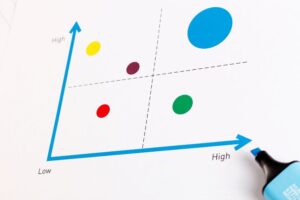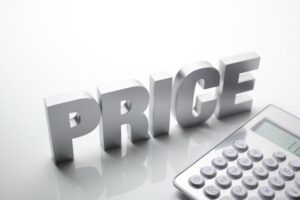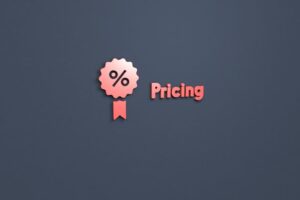Imagine you’re in the market to shop for a new Samsung smartphone, and you notice that the prices vary depending on the features and specifications of each device. The flagship Galaxy S series commands a premium price because it boasts state-of-the-art features like an edge-to-edge display, a powerful processor, multiple rear cameras, and advanced biometric security.
On the other hand, the Galaxy A series (which is more affordable) comes with a slightly less powerful processor, a single high-quality camera, and a display that still delivers an immersive viewing experience.
Finally, at the more budget-friendly end of the spectrum, the Galaxy J or M series offers decent performance, a modest camera setup, and a reliable user experience at a considerably lower price point. This diverse pricing level represents a tiered pricing strategy in practice.
Read on to learn the fundamentals of tiered pricing model, its benefits for businesses across various industries, and how you can implement it.
What is Tiered Pricing?
Tiered pricing is a strategy where products or services are offered at different price points based on predefined tiers or levels. Each tier typically offers a different set of features or benefits, allowing businesses to cater to the diverse needs and preferences of their customers.
Businesses commonly use this strategy to maximize revenue, provide options for customers with varying budgets or usage requirements, and create a sense of value differentiation. A tiered pricing strategy is structured to encourage customers to choose a higher-priced tier with increased benefits or value.
Now let’s delve into the various tiered pricing models.
Related: How Does Price Skimming Work?

Tiered Pricing Examples: 4 Tiered Pricing Models to Consider
Tiered pricing can be applied in various businesses, from software subscriptions with different levels of access and features to airline ticket pricing with the economy, business, and first-class options.
Each tier offers a distinct value proposition and caters to different customer segments. The tiers can range from basic or entry-level offerings to standard and then premium or advanced options.
The 4 tiered pricing models are as follows:
- Volume-Based Pricing Model,
- Feature-Based Pricing Model,
- Usage-Based Pricing Model,
- Subscription-Based Pricing Model.
1. Volume-Based Pricing Model
Volume-based tiered pricing offers customers lower prices or cost reductions as they purchase larger quantities or reach specific volume thresholds. It incentivizes customers to buy in bulk or increase their order volumes by offering cost savings. The cost reductions can be applied either to the per-unit cost or to the overall price of the products or services.
This pricing model creates a win-win situation for businesses and customers. Businesses benefit from increased sales volumes, higher customer retention rates, and the potential for long-term partnerships. On the other hand, customers who buy in larger quantities can save costs on their bulk orders.
Examples of Volume-Based Pricing
- Alibaba
Alibaba, the leading global online marketplace and business-to-business (B2B) platform, implements a volume-based pricing strategy for certain products and services.
Suppose a clothing retailer wants to purchase 50 sweatpants from Alibaba.com, they may get it at $12 which is the base price for the minimum quantity requirement. If the retailer decides to increase the order quantity to fall within the range of 200 to 499 units, they’ll pay only $10 for each unit, while orders of 500 and above will reduce the unit price to $8.

Related: B2B eCommerce Sales in the US.
- EcoSend
When customers require many contacts for their email campaigns, they can take advantage of the 3 tier pricing strategy on EcoSend.
This software offers 3 pricing plans – free, standard, and scale. The standard plan offers customers various price options from 2,500 to 10,000 contacts. And unit prices get cheaper as the number of contacts increases.
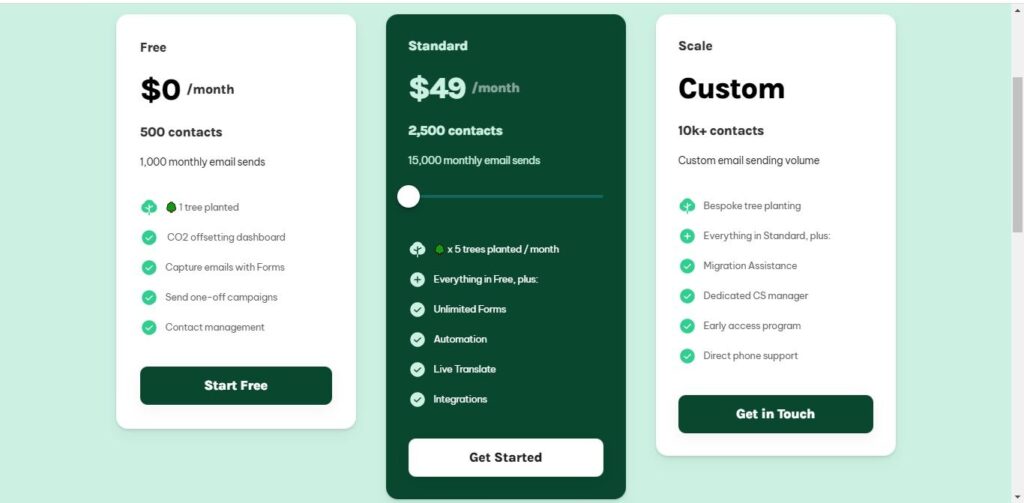
Related: What is psychological pricing?
2. Feature-Based Pricing Model
Feature-based pricing occurs when a business offers its products or services at different price points based on the specific features or functionalities included in each tier. The higher-priced tiers typically provide more advanced features, while the lower-priced tiers offer more basic or limited functionality.
The goal of feature-based pricing is to provide customers with choices and flexibility. Customers who require advanced features or are willing to pay more for enhanced capabilities can opt for higher-priced tiers, while those with simpler requirements can choose lower-priced tiers.
Examples of Feature-Based Pricing
- Canva
Canva offers a free plan that provides access to a wide range of design templates, basic editing tools, and a limited library of stock images and graphics.
Its pro subscription includes the ability to resize designs, access to a larger library of stock images and fonts, and the ability to create transparent backgrounds. In the enterprise plan, there’s advanced brand control with brand kits, access to more design templates, and the ability to upload custom fonts and assets.

3. Usage-Based Pricing Model
Companies that practice usage-based pricing determine the cost of their product or service by customers’ usage or consumption. This pricing model accommodates different usage levels, ranging from light or occasional users to heavy or frequent users. This way, customers can control their costs based on their actual usage patterns.
The structure of usage-based tiered pricing can vary depending on the product or service. Some tiers may have a fixed fee for a certain usage threshold, while others may have a variable price per unit of usage beyond the threshold. As customers exceed each threshold or consume more units, they move into higher-priced tiers offering additional usage allowances or benefits.
Examples of Usage-Based Pricing
- Amazon Web Services (AWS)
AWS offers various computing services, such as Amazon EC2 (Elastic Compute Cloud), which provides virtual servers for running applications. Customers are charged based on the size and type of instances they use, as well as the duration of usage. They are also billed based on the amount of data stored and the data transfer in and out of these services.

- Mailgun
Mailgun, a popular email marketing software, offers a usage-based pricing model that charges customers based on the number of emails sent or received using their platform. Customers typically have a monthly email limit included in their plan, and are billed based on the number of emails that exceed this limit.

4. Subscription-Based Pricing Model
Subscription-based pricing is popular in businesses where customers pay recurring fees for access to a product or service. In this pricing strategy, companies structure their subscription plans into multiple tiers, each offering a distinct set of features, functionalities, or usage allowances.
The pricing structure of subscription-based tiered pricing can vary. Some businesses may have fixed prices for each tier, while others may have incremental pricing where the cost increases as customers move to higher tiers.
Pricing tiers can also be designed based on the number of users, usage volume, or other factors relevant to the product or service.
Examples of Subscription-Based Pricing
- Zendesk
Zendesk pricing is typically structured as a recurring monthly or annual fee, and it varies depending on factors such as the number of users and the chosen plan tier. Zendesk offers multiple plan tiers to accommodate different business sizes and needs.
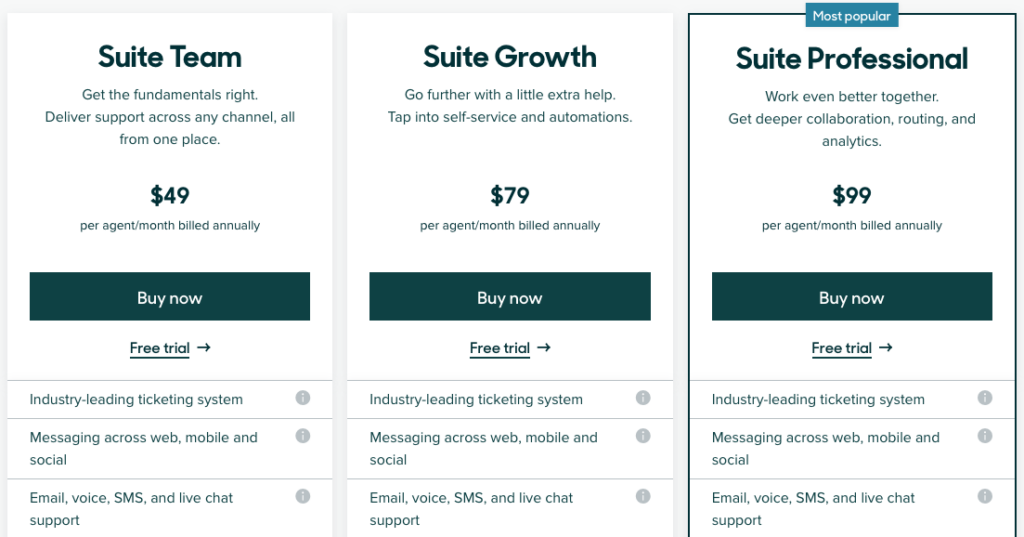
FreshBooks is an online accounting software that follows a subscription-based pricing model. It offers four pricing plans – lite, pro, plus, and select plan. These plans are structured as a recurring monthly or annual fee, depending on the user’s preference. Choosing an annual subscription often results in a discounted rate compared to the monthly option.
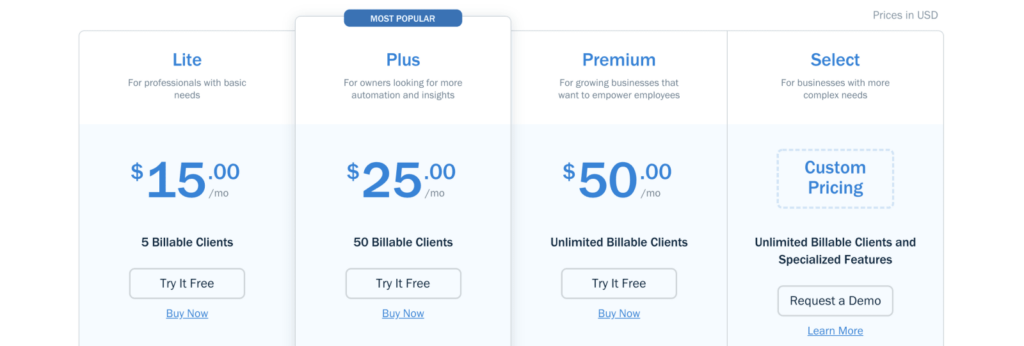
Pros and Cons of Tiered Pricing Strategy
Tiered pricing offers both advantages and a disadvantage that businesses need to consider when implementing their pricing models.
Pros of Tiered Pricing
- Increased Revenue Potential
Tiered pricing allows businesses to capture different levels of customer willingness to pay, potentially leading to higher sales and revenue.
- Customization and Flexibility
Tiered pricing enables businesses to offer multiple product or service packages, catering to various customer needs and budgets.
- Perceived Value
Different tiers can create a perception of added value, leading customers to perceive higher-priced options as having premium features or benefits.
The Con
- Complex Decision-making
Customers may find it challenging to navigate and compare multiple pricing options, potentially leading to decision paralysis or dissatisfaction. Hence, it’s important that you clearly state the value and features included in each package to help your customers make a better fitting choice for their business.
How to Implement a Tiered Pricing Strategy in Your Business
The success of every business strategy is determined by careful considerations on some key factors. In this case, you need to keep a close eye on market dynamics, competitor pricing strategies, and customer preferences. Here are some of the key best practices to successfully implement tiered pricing strategy:
1. Understand Your Customers
To implement a successful tiered pricing strategy, you must understand your target customers and their needs. This step involves conducting market research and gathering data to identify distinct customer segments within your target market. Some key factors to consider are demographics, purchasing behaviors, preferences, and willingness to pay.
2. Define Pricing Tiers
Determine the number of pricing tiers you want and the criteria that differentiate each level. Most organizations use a 3 tier pricing strategy (Basic, Standard, and Premium).
Identify the key factors that differentiate each pricing tier from the others. These factors could include:
- The level of service,
- Additional features,
- Access to exclusive content or resources,
- Priority support,
- Customization options.
The goal is to create value distinctions between tiers that justify the price differences provided.
3. Set Pricing Levels
Setting the right prices requires a combination of market analysis, competitive research, and understanding the perceived value of your offerings. Conduct surveys and gather customer feedback to evaluate how much they are willing to pay for the features and benefits provided at each tier. Additionally, consider your cost structure and desired profit margins when setting pricing levels.
4. Test and Refine
Start by launching the tiered pricing model on a smaller scale or with a specific customer segment to gather feedback and assess its effectiveness. Monitor essential metrics, customer feedback, and sales data to identify any areas for improvement.
Consider conducting another survey to gain insights into their perception of the value provided by each tier. Based on this information, adjust your pricing, features, or messaging to optimize the strategy and enhance customer satisfaction.
5. Monitor and Optimize
Continuous monitoring and optimization are crucial for the long-term success of your tiered pricing strategy. Regularly analyze and review key performance indicators such as revenue, customer acquisition, retention rates, and customer satisfaction scores.
Identify any trends, patterns, or areas of underperformance across different tiers. Use this data to refine your pricing levels, adjust feature offerings, or introduce new tiers based on customer demand.
Key Takeaway
A well-executed tiered pricing strategy can drive customer satisfaction, increase average order value, and capture a broader range of customers by offering options at different price points.
However, it requires careful consideration of market dynamics, customer preferences, and the perceived value of each tier to ensure the strategy aligns with business goals and generates sustainable profitability.
For more pricing information and resources, visit our SaaS Pricing site.
Related Posts
Frequently Asked Questions (FAQ)
Author
Methodology
- Who?
We are SaaS experts: Our specialists constantly seek the most relevant information to help support your SaaS business. - Why?
We are passionate about users accessing fair SaaS pricing: We offer up-to-date pricing data, reviews, new tools, blogs and research to help you make informed SaaS pricing decisions. - How?
With accurate information: Our website manager tests each software to add a Genius Score using our rating methodology to each product. Our editorial team fact-check every piece of content we publish, and we use first-hand testing, value metrics and leading market data.

